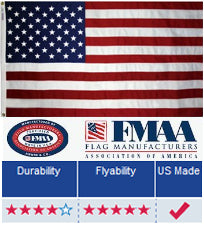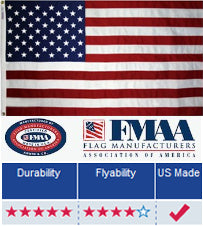Star Spangled Banner
By Isaac Asimov
Written by the late Isaac Asimov, in March 1991. Asimov was born in Russia, and emigrated in 1923 with his parents when he was a young child. He became an American citizen in 1928.
I have a weakness - I am crazy, absolutely nuts, about our national anthem. The words are difficult, and the tune is almost impossible, but frequently when I'm taking a shower, I sing it with as much power and emotion as I can. It shakes me up every time. I was once asked to speak at a luncheon. Taking my life in my hands, I announced I was going to sing our national anthem - all four stanzas. This was greeted with loud groans. One man closed the door to the kitchen, where the noise of dishes and cutlery was loud and distracting. "Thanks, Herb," I said. "That's all right," he said. "It was at the request of the kitchen staff."
I explained the background of the anthem, and then sang all four stanzas. Let me tell you, those people had never heard it before - or had never really listened. I got a standing ovation. But, it was not me; it was the anthem.
More recently, while conducting a seminar, I told my students the story of the anthem, and sang all four stanzas. Again, there was a wild ovation and prolonged applause. And again, it was the anthem, and not me. So, now let me tell you how it came to be written.
In 1812, the United States went to war with Great Britain, primarily over freedom of the seas. We were in the right. For two years, we held off the British, even though we were still a rather weak country. Great Britain was in a life and death struggle with Napoleon. In fact, just as the United States declared war, Napoleon marched off to invade Russia. If he won, as everyone expected, he would control Europe, and Great Britain would be isolated. It was no time for her to be involved in an American war.
At first, our seamen proved better than the British. After we won a battle on Lake Erie in 1813, the American commander, Oliver Hazard Perry, sent the message "We have met the enemy, and they are ours." However, the weight of the British navy beat down our ships, eventually. New England, hard-hit by a tightening blockade, threatened secession.
Meanwhile, Napoleon was beaten in Russia and, in 1814, was forced to abdicate. Great Britain now turned its attention to the United States, launching a three-pronged attack. The Northern prong was to come down Lake Champlain toward New York, and seize parts of New England. The Southern prong was to go up the Mississippi, take New Orleans and paralyze the West. The Central prong was to head for the Mid-Atlantic states, and then attack Baltimore, the greatest port South of New York. If Baltimore was taken, the nation, which still hugged the Atlantic coast, could be split in two. The fate of the United States, then, rested, to a large extent, on the success or failure of the Central prong.
The British reached the American coast, and on August 24, 1814, took Washington, D.C. Then they moved up the Chesapeake Bay, toward Baltimore. On September 12, they arrived and found 1,000 men in Fort McHenry, whose guns controlled the harbor. If the British wished to take Baltimore, they would have to take the Fort.
On one of the British ships was an aged physician, William Beanes, who had been arrested in Maryland, and brought along as a prisoner. Francis Scott Key, a lawyer and friend of the physician, had come to the ship to negotiate his release. The British Captain was willing, but the two Americans would have to wait. It was now the night of Tuesday, September 13, 1814, and the bombardment of Fort McHenry was about to start.
As twilight deepened, Key and Beanes saw the American flag flying over Fort McHenry. Through the night, they heard bombs bursting, and saw the red glare of rockets. They knew the Fort was resisting, and the American flag was still flying. But, toward morning, the bombardment ceased, and a dreaded silence fell. Either Fort McHenry had surrendered, and the British flag flew above it; or the bombardment had failed, and the American flag still flew.
As dawn began to brighten the Eastern sky, Key and Beanes stared out at the Fort, tyring to see which flag flew over it. He and the physician must have asked each other, over and over, "Can you see the flag?"
After it was all finished, Key wrote a four-stanza poem telling the events of the night. He called it The Defence of Fort McHenry, and it was published in newspapers, and swept the nation. Someone noted that the words fit an old English tune called To Anacreon in Heaven - a difficult melody, with an uncomfortably large vocal range. For obvious reasons, Key's work became known as The Star Spangled Banner, and in 1931, Congress declared it the official anthem of the United States.
Now that you know the story, here are the words. Presumably, the old doctor is speaking. This is what he asks Key:
Star Spangled Banner
Oh! say, can you see, by the dawn's early light,
What so proudly we hailed at the twilight's last gleaming?
Whose broad stripes and bright stars, through the perilous fight,
O'er the ramparts we watched, were so gallantly streaming?
And the rocket's red glare, the bombs bursting in air,
Gave proof thro' the night that our flag was still there.
Oh! say, does that star-spangled banner yet wave,
O'er the land of the free and the home of the brave?
("Ramparts," in case you don't know, are the protective walls or other elevations that surround a Fort. The first stanza asks a question. The second gives an answer. )
On the shore, dimly seen thro' the mist of the deep,
Where the foe's haughty host in dread silence reposes,
What is that which the breeze, o'er the towering steep.
As it fitfully blows, half conceals, half discloses?
Now it catches the gleam of the morning's first beam,
In full glory reflected, now shines on the stream.
'Tis the star-spangled banner. Oh! long may it wave,
O'er the land of the free and the home of the brave!
("The towering steep" is again, the ramparts. The bombardment has failed, and the British can do nothing more but sail away, their mission a failure. In the third stanza, I feel Key allows himself to gloat over the American triumph. In the aftermath of the bombardment, Key probably was in no mood to act otherwise. During World War II, when the British were our staunchest allies, this third stanza was not sung. However, I know it, so here it is)
And where is that band who so vauntingly swore,
That the havoc of war and the battle's confusion
A home and a country should leave us no more?
Their blood has washed out their foul footstep's pollution.
No refuge could save the hireling and slave,
From the terror of flight, or the gloom of the grave,
And the star-spangled banner in triumph doth wave,
O'er the land of the free and the home of the brave.
(The fourth stanza, a pious hope for the future, should be sung more slowly than the other three, and with even deeper feeling. )
Oh! Thus be it ever, when freemen shall stand,
Between their loved homes and the war's desolation,
Blest with vict'ry and peace, may the Heav'n - rescued land,
> Praise the Pow'r that hath made and preserved us a nation.
Then conquer we must, for our cause is just,
And this be our motto - "In God is our trust."
And the star-spangled banner in triumph doth wave,
O'er the land of the free and the home of the brave.
I hope you will look at the national anthem with new eyes. Listen to it, the next time you have a chance, with new ears.
And, don't let them ever take it away


